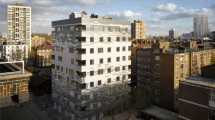Abstract
The long-term goal of this research is to improve the fire resistance of gypsum wallboard (GWB). GWB consists mainly of gypsum, i.e., calcium sulfate dihydrate, CaSO4·2H2O. In buildings, the chemical, mechanical, and thermal properties of GWB play an important role in delaying the spread of fire. To build a fire resistant GWB, it is very important to study the thermal, mechanical, physical, and chemical properties of regular GWB and various types of fire resistant wallboards available commercially in the market. Various fire resistant GWBs have been compared and contrasted with reference to a standard wallboard in this study. Regardless of the type of wallboard, the main component is gypsum. The fire resistance property is mainly attributed to the absorption of energy related with the loss of hydrate water going from the dihydrate (CaSO4·2H2O) form to the hemihydrate (CaSO4·½H2O) and from the hemihydrate to the anhydrous form (CaSO4) in a second decomposition. The present paper is a comparative study of commercially available standard, fire-rated Type X, and fire-rated Type C GWBs. Type X wallboards are typically reinforced with non-combustible fibers so as to protect the integrity of the wallboard during thermal shrinkage, while the Type C wallboards are incorporated with more glass fibers and an additive, usually a form of vermiculite. These Type C wallboards have a shrinkage adjusting element that expands when exposed to elevated temperature. Differential scanning calorimetry, thermogravimetric analysis, thermomechanical analysis, and powder X-ray diffraction were used to characterize and compare the materials. Various properties, such as the heat flow, mass loss, dimensional changes, morphology, and crystalline structures of the GWBs were studied using these techniques.






























Similar content being viewed by others
References
Freyer D, Voigt W. Crystallization and phase stability of CaSO4 and CaSO4 based salts. Monatsch Chem. 2003;134:693–5.
Thomas G. Thermal properties of gypsum plasterboard at high temperatures. Fire Mater. 2006;26:37–9.
Deutsch Y, Nathan Y, Sarig S. Thermogravimetric evaluation of the kinetics of the gypsum hemihydrate soluble anhydrite transitions. J Therm Anal. 1994;42:159–62.
Cole E, Lancucki C. A refinement of the crystal structure of gypsum CaSO4·2H2O. Acta Crystallogr B. 1974;30:921–4.
Pedersen B, Semminsen D. Neutron diffraction refinement of the structure of gypsum CaSO4·2H2O. Acta Crystallogr B. 1982;38:1074–6.
Schofield PF, Wilson CC, Knight KS, Stretton IC. Temperature related structural variation of the hydrous components in gypsum. Z Kristallogr. 2000;215:707–9.
Ramachandran VS. Handbook of thermal analysis of construction materials. Norwich: Noyes Publications; 2003.
Chang H, Huang JP, Hou SC. Application of thermo Raman spectroscopy to study dehydration of calcium sulfate dihydrate to calcium sulfate hemihydrate. Mater Chem Phys. 1999;58:12–5.
ASTM C36/C36M-03e1. Standard specification for gypsum wallboard. West Conshohocken: ASTM International; 2001.
James Beaudoin J, Rolf Feldman F. Mechanism of dehydration of Calcium sulfate dihydrate. J Chem Soc. 1983;79:2071–4.
Lewry AJ, Willianson J. The setting of gypsum plaster, part 1: the hydration of calcium sulfate hemihydrate. J Mater Sci. 1994B; 29:5279–81.
Lewry AJ, Willianson J. The setting of gypsum plaster, part 2: the development of micro structure and strength. J Mater Sci. 1994C; 29:5524–6.
Mehaffey JR, Cuerrier P, Carisse GA. A model for predicting heat transfer through gypsum board wood stud walls exposed to fire. Fire Mater. 1994;18:297–9.
Borrachero MV, Paya J, Bonilla M, Monzo J. The use of Thermogravimetric analysis technique for the characterization of construction materials: the gypsum case. J Therm Anal Calorim. 2008;91:503–6.
Kuntze RA. Effect of water vapor on the formation of CaSO4·2H2O modifications. J Chem Soc. 1965;43:2522–5.
Baux C, Melinge Y, Lanos C, Jauberthie R. Enhanced gypsum panels for fire protection. J Mater Civil Eng. 2008;20:71–4.
ASTM C1396/C1396M-01. Standard specifications for gypsum board. West Conshohocken: ASTM International; 2001.
Yu L, Brouwers JH. Thermal properties and microstructure of gypsum board and its dehydration products: a theoretical and experimental investigation. Fire Mater. 2012;36:575–9.
Atoji M, Rundle R. Neuron diffraction study of gypsum, CaSO4·2H2O. J Chem Phys. 1958;29:1306–9.
Hudson Lamb DL, Strydom CA, Potgieter JH. The thermal dehydration of natural gypsum and pure calcium sulfate dihydrate (gypsum). Thermochim Acta. 1996; 282/283:483–6.
Paulik F, Paulik J, Arnold M. Thermal decomposition of gypsum. Thermochim Acta. 1992;200:195–8.
Wullschleger L, Ghazi Wakili K. Numerical parameter study of the thermal behavior of gypsum plaster board at fire temperature. Fire Mater. 2007;32:103–6.
Samuel M, Richard G, Scott Kukuck R, David Lenhert B. Influence of gypsum board type (X or C) on real fire performance of partition assemblies. Fire Mater. 2007;31:425–8.
Author information
Authors and Affiliations
Corresponding author
Rights and permissions
About this article
Cite this article
Javangula, H., Lineberry, Q. Comparative studies on fire-rated and standard gypsum wallboard. J Therm Anal Calorim 116, 1417–1433 (2014). https://doi.org/10.1007/s10973-014-3795-2
Received:
Accepted:
Published:
Issue Date:
DOI: https://doi.org/10.1007/s10973-014-3795-2




